语言学
- 格式:doc
- 大小:178.50 KB
- 文档页数:21
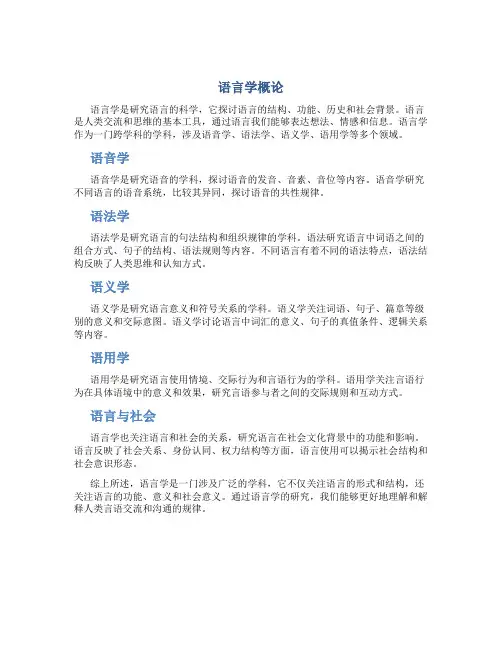
语言学概论
语言学是研究语言的科学,它探讨语言的结构、功能、历史和社会背景。
语言是人类交流和思维的基本工具,通过语言我们能够表达想法、情感和信息。
语言学作为一门跨学科的学科,涉及语音学、语法学、语义学、语用学等多个领域。
语音学
语音学是研究语音的学科,探讨语音的发音、音素、音位等内容。
语音学研究不同语言的语音系统,比较其异同,探讨语音的共性规律。
语法学
语法学是研究语言的句法结构和组织规律的学科。
语法研究语言中词语之间的组合方式、句子的结构、语法规则等内容。
不同语言有着不同的语法特点,语法结构反映了人类思维和认知方式。
语义学
语义学是研究语言意义和符号关系的学科。
语义学关注词语、句子、篇章等级别的意义和交际意图。
语义学讨论语言中词汇的意义、句子的真值条件、逻辑关系等内容。
语用学
语用学是研究语言使用情境、交际行为和言语行为的学科。
语用学关注言语行为在具体语境中的意义和效果,研究言语参与者之间的交际规则和互动方式。
语言与社会
语言学也关注语言和社会的关系,研究语言在社会文化背景中的功能和影响。
语言反映了社会关系、身份认同、权力结构等方面,语言使用可以揭示社会结构和社会意识形态。
综上所述,语言学是一门涉及广泛的学科,它不仅关注语言的形式和结构,还关注语言的功能、意义和社会意义。
通过语言学的研究,我们能够更好地理解和解释人类言语交流和沟通的规律。
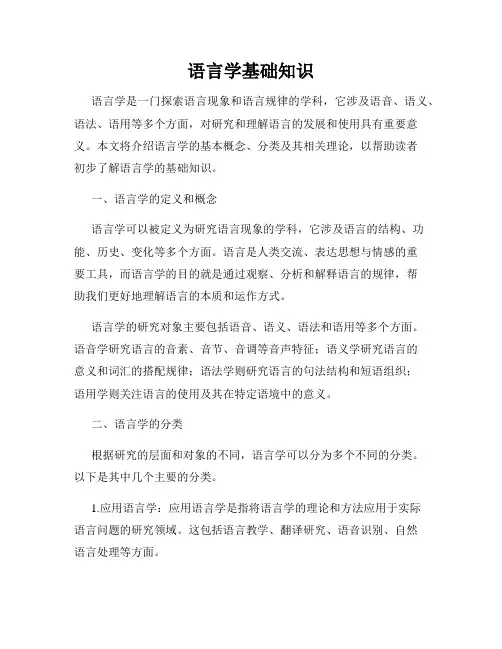
语言学基础知识语言学是一门探索语言现象和语言规律的学科,它涉及语音、语义、语法、语用等多个方面,对研究和理解语言的发展和使用具有重要意义。
本文将介绍语言学的基本概念、分类及其相关理论,以帮助读者初步了解语言学的基础知识。
一、语言学的定义和概念语言学可以被定义为研究语言现象的学科,它涉及语言的结构、功能、历史、变化等多个方面。
语言是人类交流、表达思想与情感的重要工具,而语言学的目的就是通过观察、分析和解释语言的规律,帮助我们更好地理解语言的本质和运作方式。
语言学的研究对象主要包括语音、语义、语法和语用等多个方面。
语音学研究语言的音素、音节、音调等音声特征;语义学研究语言的意义和词汇的搭配规律;语法学则研究语言的句法结构和短语组织;语用学则关注语言的使用及其在特定语境中的意义。
二、语言学的分类根据研究的层面和对象的不同,语言学可以分为多个不同的分类。
以下是其中几个主要的分类。
1.应用语言学:应用语言学是指将语言学的理论和方法应用于实际语言问题的研究领域。
这包括语言教学、翻译研究、语音识别、自然语言处理等方面。
2.历史语言学:历史语言学研究语言的发展和演变。
它通过比较不同时期和地区的语言形态、语法、词汇等,揭示语言的历史变化规律。
3.形态学:形态学研究词汇的内部结构和构词规律。
它关注词的形态形式、词根、词缀等,以及它们在句中的使用方式和句法功能。
4.句法学:句法学研究句子的结构和组成。
它关注词与词之间的关系以及它们按照一定规律组合而成的短语、从句和主句等句法单位。
5.语音学:语音学研究语言的音素、音节和音调等音声特征。
它通过观察和描述语言的发音规律,揭示不同语言之间的音位差异和音变规律。
6.语义学:语义学研究语言的意义和词汇的表义关系。
它关注词语之间的意义关联和句子的语义结构,帮助我们理解语言中的暗示、隐喻和逻辑关系。
三、语言学的相关理论1. 结构主义:结构主义是20世纪初发展起来的一种语言学理论,强调语言的内在结构和规律。
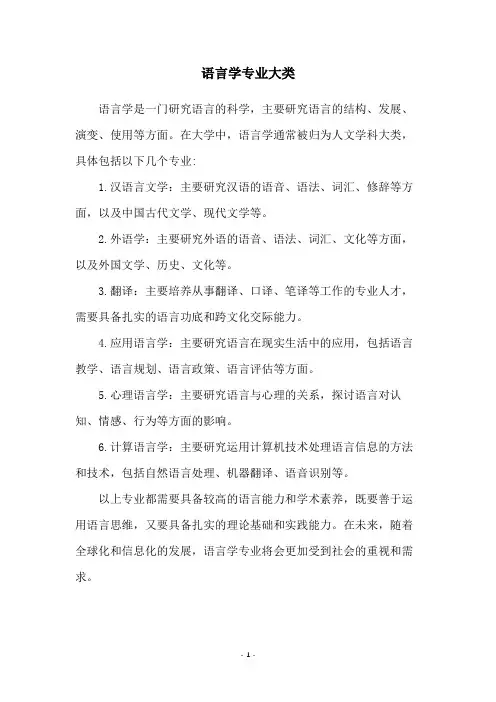
语言学专业大类
语言学是一门研究语言的科学,主要研究语言的结构、发展、演变、使用等方面。
在大学中,语言学通常被归为人文学科大类,具体包括以下几个专业:
1.汉语言文学:主要研究汉语的语音、语法、词汇、修辞等方面,以及中国古代文学、现代文学等。
2.外语学:主要研究外语的语音、语法、词汇、文化等方面,以及外国文学、历史、文化等。
3.翻译:主要培养从事翻译、口译、笔译等工作的专业人才,需要具备扎实的语言功底和跨文化交际能力。
4.应用语言学:主要研究语言在现实生活中的应用,包括语言教学、语言规划、语言政策、语言评估等方面。
5.心理语言学:主要研究语言与心理的关系,探讨语言对认知、情感、行为等方面的影响。
6.计算语言学:主要研究运用计算机技术处理语言信息的方法和技术,包括自然语言处理、机器翻译、语音识别等。
以上专业都需要具备较高的语言能力和学术素养,既要善于运用语言思维,又要具备扎实的理论基础和实践能力。
在未来,随着全球化和信息化的发展,语言学专业将会更加受到社会的重视和需求。
- 1 -。
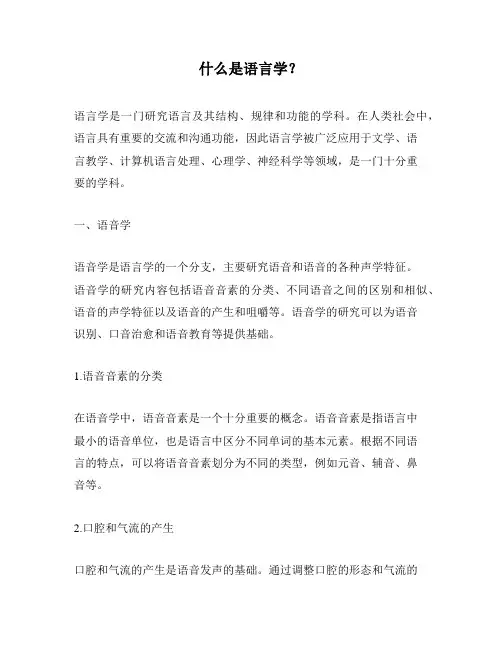
什么是语言学?语言学是一门研究语言及其结构、规律和功能的学科。
在人类社会中,语言具有重要的交流和沟通功能,因此语言学被广泛应用于文学、语言教学、计算机语言处理、心理学、神经科学等领域,是一门十分重要的学科。
一、语音学语音学是语言学的一个分支,主要研究语音和语音的各种声学特征。
语音学的研究内容包括语音音素的分类、不同语音之间的区别和相似、语音的声学特征以及语音的产生和咀嚼等。
语音学的研究可以为语音识别、口音治愈和语音教育等提供基础。
1.语音音素的分类在语音学中,语音音素是一个十分重要的概念。
语音音素是指语言中最小的语音单位,也是语言中区分不同单词的基本元素。
根据不同语言的特点,可以将语音音素划分为不同的类型,例如元音、辅音、鼻音等。
2.口腔和气流的产生口腔和气流的产生是语音发声的基础。
通过调整口腔的形态和气流的流动速度,人类可以发出各种不同的语音。
因此,语音学研究如何调整口腔的形态和气流的流动速度,以及如何在不同语言中发出完整的语音。
3.声学特征分析语音学的另一个重要任务是分析语音的声学特征。
语音具有不同的频率、幅度和相位等特征,这些特征可以用来区分不同的语音。
为了研究语音的声学特征,语音学需要采集音频数据,并通过计算机软件将音频数据转换成可视化信息。
二、语法学语法学是语言学的另一个分支,主要研究语言中的句子、短语、词汇和语言结构等。
语法学的研究可以帮助人们理解语言的构成和使用规律,对于语言教育和机器翻译等应用也有重要的意义。
1.句法分析句法分析是语法学的一个重要研究领域,主要研究句子中的词汇、短语和语法关系等。
通过对句子结构的分析,可以理解其含义,进而实现语言的交流。
句法分析的方法包括树状结构分析、依存语法分析等。
2.词法分析语言中的词汇是由若干语音、音节组成的,词法分析主要研究词汇的形态、构成和变化等规律。
通过对词汇的分析,可以理解其在不同句子中的含义和使用方法。
3.语法关系分析语法关系分析是语法学的另一个研究方向,主要研究语言的不同成分之间的关系。

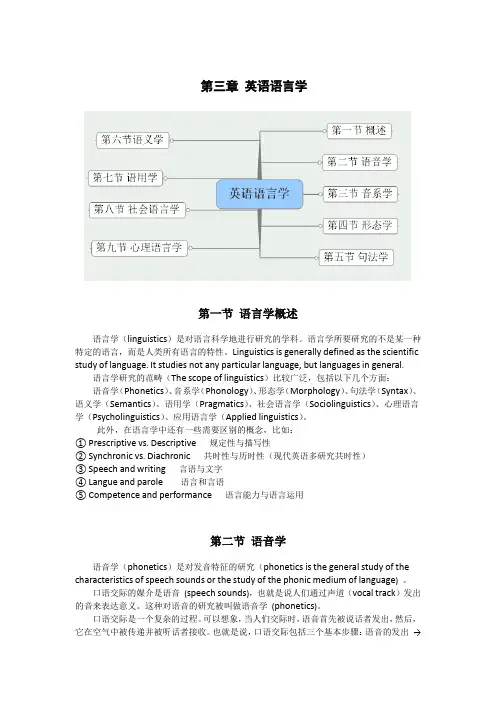
第三章英语语言学第一节语言学概述语言学(linguistics)是对语言科学地进行研究的学科。
语言学所要研究的不是某一种特定的语言,而是人类所有语言的特性。
Linguistics is generally defined as the scientific study of language. It studies not any particular language,but languages in general.语言学研究的范畴(The scope of linguistics)比较广泛,包括以下几个方面:语音学(Phonetics)、音系学(Phonology)、形态学(Morphology)、句法学(Syntax)、语义学(Semantics)、语用学(Pragmatics)、社会语言学(Sociolinguistics)、心理语言学(Psycholinguistics)、应用语言学(Applied linguistics)。
此外,在语言学中还有一些需要区别的概念,比如:① Prescriptive vs. Descriptive规定性与描写性② Synchronic vs. Diachronic共时性与历时性(现代英语多研究共时性)③ Speech and writing言语与文字④ Langue and parole语言和言语⑤ Competence and performance语言能力与语言运用第二节语音学语音学(phonetics)是对发音特征的研究(phonetics is the general study of the characteristics of speech sounds or the study of the phonic medium of language) 。
口语交际的媒介是语音(speech sounds),也就是说人们通过声道(vocal track)发出的音来表达意义。
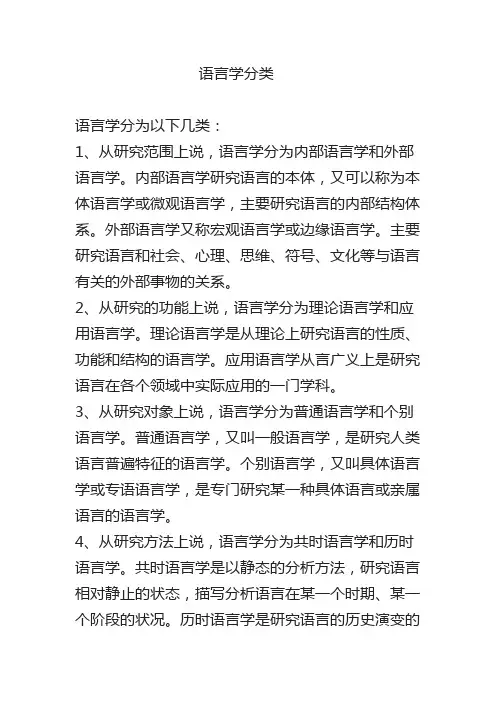
语言学分类
语言学分为以下几类:
1、从研究范围上说,语言学分为内部语言学和外部语言学。
内部语言学研究语言的本体,又可以称为本体语言学或微观语言学,主要研究语言的内部结构体系。
外部语言学又称宏观语言学或边缘语言学。
主要研究语言和社会、心理、思维、符号、文化等与语言有关的外部事物的关系。
2、从研究的功能上说,语言学分为理论语言学和应用语言学。
理论语言学是从理论上研究语言的性质、功能和结构的语言学。
应用语言学从言广义上是研究语言在各个领域中实际应用的一门学科。
3、从研究对象上说,语言学分为普通语言学和个别语言学。
普通语言学,又叫一般语言学,是研究人类语言普遍特征的语言学。
个别语言学,又叫具体语言学或专语语言学,是专门研究某一种具体语言或亲属语言的语言学。
4、从研究方法上说,语言学分为共时语言学和历时语言学。
共时语言学是以静态的分析方法,研究语言相对静止的状态,描写分析语言在某一个时期、某一个阶段的状况。
历时语言学是研究语言的历史演变的
科学。
它研究一种语言的各个结构要素在不同发展阶段的历史演变,研究语言的发展规律。
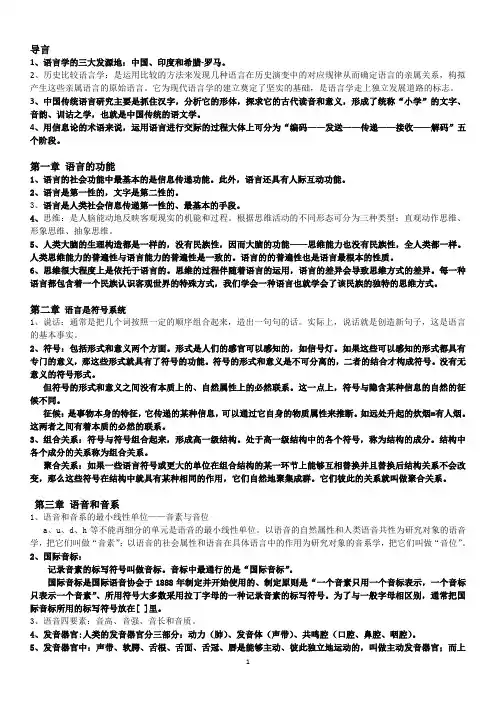
导言1、语言学的三大发源地:中国、印度和希腊-罗马。
2、历史比较语言学:是运用比较的方法来发现几种语言在历史演变中的对应规律从而确定语言的亲属关系,构拟产生这些亲属语言的原始语言。
它为现代语言学的建立奠定了坚实的基础,是语言学走上独立发展道路的标志。
3、中国传统语言研究主要是抓住汉字,分析它的形体,探求它的古代读音和意义,形成了统称“小学”的文字、音韵、训诂之学,也就是中国传统的语文学。
4、用信息论的术语来说,运用语言进行交际的过程大体上可分为“编码——发送——传递——接收——解码”五个阶段。
第一章语言的功能1、语言的社会功能中最基本的是信息传递功能。
此外,语言还具有人际互动功能。
2、语言是第一性的,文字是第二性的。
3、语言是人类社会信息传递第一性的、最基本的手段。
4、思维:是人脑能动地反映客观现实的机能和过程。
根据思维活动的不同形态可分为三种类型:直观动作思维、形象思维、抽象思维。
5、人类大脑的生理构造都是一样的,没有民族性,因而大脑的功能——思维能力也没有民族性,全人类都一样。
人类思维能力的普遍性与语言能力的普遍性是一致的。
语言的的普遍性也是语言最根本的性质。
6、思维很大程度上是依托于语言的。
思维的过程伴随着语言的运用,语言的差异会导致思维方式的差异。
每一种语言都包含着一个民族认识客观世界的特殊方式,我们学会一种语言也就学会了该民族的独特的思维方式。
第二章语言是符号系统1、说话:通常是把几个词按照一定的顺序组合起来,造出一句句的话。
实际上,说话就是创造新句子,这是语言的基本事实。
2、符号:包括形式和意义两个方面。
形式是人们的感官可以感知的,如信号灯。
如果这些可以感知的形式都具有专门的意义,那这些形式就具有了符号的功能。
符号的形式和意义是不可分离的,二者的结合才构成符号。
没有无意义的符号形式。
但符号的形式和意义之间没有本质上的、自然属性上的必然联系。
这一点上,符号与隐含某种信息的自然的征候不同。
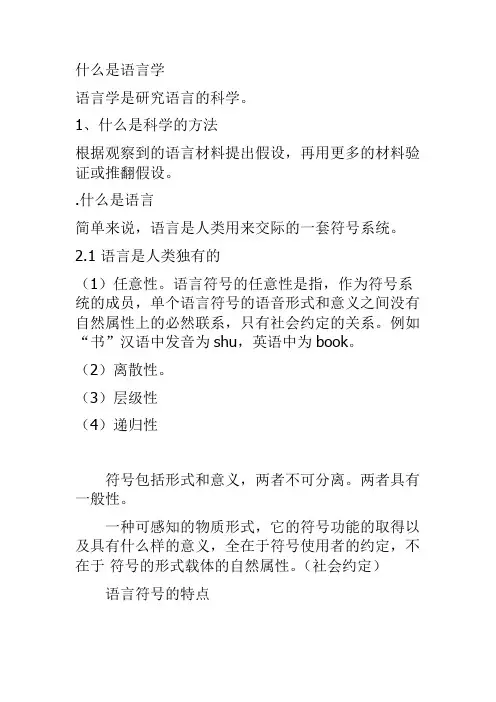
什么是语言学语言学是研究语言的科学。
1、什么是科学的方法根据观察到的语言材料提出假设,再用更多的材料验证或推翻假设。
.什么是语言简单来说,语言是人类用来交际的一套符号系统。
2.1 语言是人类独有的(1)任意性。
语言符号的任意性是指,作为符号系统的成员,单个语言符号的语音形式和意义之间没有自然属性上的必然联系,只有社会约定的关系。
例如“书”汉语中发音为shu,英语中为book。
(2)离散性。
(3)层级性(4)递归性符号包括形式和意义,两者不可分离。
两者具有一般性。
一种可感知的物质形式,它的符号功能的取得以及具有什么样的意义,全在于符号使用者的约定,不在于符号的形式载体的自然属性。
(社会约定)语言符号的特点(1)语言符号的任意性:语言符号的任意性是指,作为符号系统的成员,单个语言符号的语音形式和意义之间没有自然属性上的必然联系,只有社会约定的关系。
例如“书”汉语中发音为shu,英语中为book。
符号与征候(2)语言符号的线条性:语言符号在使用中以符号序列的形式出现,语言符号在时间中展开,线条性是语言符号分析的基础。
(3)语言符号的系统性:音系(音位)和语法(音素)两个层面。
分层语言的底层是一套音位,语言的上层是音义结合的符号和符号的序列,这一层又分为若干级。
第一级是语素,意义在这里被装进形式的口袋,成了音义结合的最小的符号。
第二级是由语素构成的词,第三级是由词构成的句子。
词和句子都是符号的序列。
语言符号的组合关系与聚合关系(1)组合关系是指语言单位线性组合时产生的相互关系。
P31音位的组合:/x//a//u/;语素的组合:语—言;词的组合:语言—类型;词组的组合:老师和同学共同研究语言学。
(2)聚合关系是语言单位按某些共同点相互联系的潜在关系。
例如“红花”红可以用白、紫、粉等代替,花可以用光、线、房子等代替,此时这两组词构成聚合。
语言与言语(1)言语即说话,是具体语言行为的结果。
(2)语言是说话依循的材料和规则。
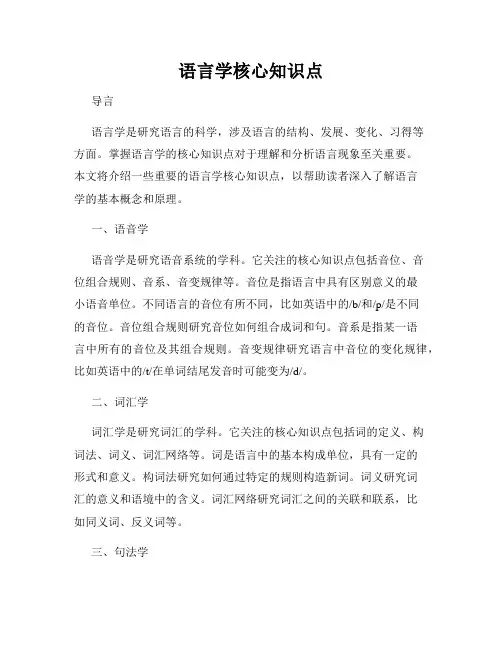
语言学核心知识点导言语言学是研究语言的科学,涉及语言的结构、发展、变化、习得等方面。
掌握语言学的核心知识点对于理解和分析语言现象至关重要。
本文将介绍一些重要的语言学核心知识点,以帮助读者深入了解语言学的基本概念和原理。
一、语音学语音学是研究语音系统的学科。
它关注的核心知识点包括音位、音位组合规则、音系、音变规律等。
音位是指语言中具有区别意义的最小语音单位。
不同语言的音位有所不同,比如英语中的/b/和/p/是不同的音位。
音位组合规则研究音位如何组合成词和句。
音系是指某一语言中所有的音位及其组合规则。
音变规律研究语言中音位的变化规律,比如英语中的/t/在单词结尾发音时可能变为/d/。
二、词汇学词汇学是研究词汇的学科。
它关注的核心知识点包括词的定义、构词法、词义、词汇网络等。
词是语言中的基本构成单位,具有一定的形式和意义。
构词法研究如何通过特定的规则构造新词。
词义研究词汇的意义和语境中的含义。
词汇网络研究词汇之间的关联和联系,比如同义词、反义词等。
三、句法学句法学是研究句子结构的学科。
它关注的核心知识点包括短语、句子成分、句子类型、句子结构等。
短语是指由几个词构成的有意义的单位,可以是名词短语、动词短语等。
句子成分研究句子中的各个组成部分,比如主语、谓语、宾语等。
句子类型研究不同类型的句子结构和语法规则,比如陈述句、疑问句等。
句子结构研究句子内部各个成分的排列顺序和关系。
四、语义学语义学是研究句子含义的学科。
它关注的核心知识点包括词义、句义、语用学等。
词义研究词的具体含义和义项,如形容词的描述性义和评价义。
句义研究句子的整体含义和逻辑关系,如假设、推理等。
语用学研究语言使用的上下文和交际功能,如言外之意、言外之意等。
五、语篇学语篇学是研究连续语言材料的学科。
它关注的核心知识点包括信息结构、语段、修辞学等。
信息结构研究语言材料的信息组织方式,如主题句和衔接词的使用。
语段研究语言材料的段落和篇章结构,如起承转合、总分结构等。
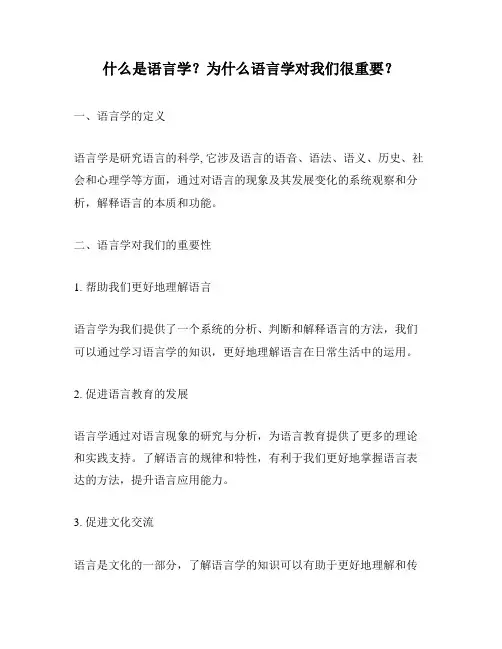
什么是语言学?为什么语言学对我们很重要?
一、语言学的定义
语言学是研究语言的科学, 它涉及语言的语音、语法、语义、历史、社会和心理学等方面,通过对语言的现象及其发展变化的系统观察和分析,解释语言的本质和功能。
二、语言学对我们的重要性
1. 帮助我们更好地理解语言
语言学为我们提供了一个系统的分析、判断和解释语言的方法,我们可以通过学习语言学的知识,更好地理解语言在日常生活中的运用。
2. 促进语言教育的发展
语言学通过对语言现象的研究与分析,为语言教育提供了更多的理论和实践支持。
了解语言的规律和特性,有利于我们更好地掌握语言表达的方法,提升语言应用能力。
3. 促进文化交流
语言是文化的一部分,了解语言学的知识可以有助于更好地理解和传
递文化信息。
通过对语言的学习和掌握,跨文化交流可以变得更加顺
畅和有效。
4. 帮助我们更好地理解自身与世界
语言是人类认知和交流的重要工具,在通过语言学学习语言的过程中,我们能够更深入地了解自身思考方式与认知图景,以及其他文化背景
的人的不同认知和交流方式。
5. 促进语言科技的发展
随着人工智能技术的发展,语言科技也逐渐成为科技行业的一个重要
领域。
语言学对于语音识别、自然语言处理、机器翻译等方面的发展
有着重要的贡献。
综上所述,语言学的学习不仅有助于我们提高语言应用能力,更能够
帮助我们更好地了解自身和他人之间的交流方式和文化特点,在多元
文化的今天具有非常重要的意义。
(一)名词解释1.语言学:语言学是以人类语言作为研究对象的学科,研究人类语言的性质、结构、发展及其在社会生活中的运用以及语言研究成果的应用问题,等等。
分理论语言学和应用语言学两个领域。
2.“小学”:在中国古代,小学先从教授字的形(六书)、音、义开始,就把研究文字、训诂、音韵方面的学问统称为小学。
小学一直是经学的一部分,包括音韵学、训诂学、文字学三个分支学科。
3.非语言交际工具或副语言交际工具:人们在运用语言进行交际的时候,不但动嘴,而且脸部的表情、手的动作、乃至整个躯体的姿态等非语言的东西也都参加进来。
我们这些非语言的交际工具称为副语言交际工具。
副语言交际工具的使用范围非常有限,只能起辅助性的交际作用,以补充语言交际的某些不足。
4.辅助性交际工具:指的文字、旗语、电报代码等在语言的基础上产生的交际工具。
这些交际工具若离开语言就不能独立存在。
其特点是:都有特殊的服务领域,使用的范围相当狭窄。
5.符号:符号,就是指代某种事物的标记,记号,它是由一个社会的全体成员共同约定用来表示某种意义的标记和记号。
6.符号的任意性:任意性是语言符号的本质特征之一。
其含义是:语言符号的音义联系并非是本质的,必然的,而是由社会成员共同约定的,一种意义为什么要用这个声音形式,而不用那种声音形式,这中间没有什么道理可言,完全是偶然的、任意的。
语言符号和客观事物之间也没有必然联系。
7.语言符号:特定语言系统中作为音义结合体的语言单位称为语言符号。
与一般符号相比,语言符号的主要特点是:音义结合的任意性、能指的线性特征、所指组合的层次性等等。
8.语言的层级体系:语言的层级体系:语言的底层是一套音位,一种语言的音位的数目虽然只有几十个,却能构成数目众多的组合。
这些组合为语言符号准备了形式的部分。
语言的上层是音义结合的符号和符号的序列,这一层又分为若干级。
第一级是语素,意义在这里被装进形式的口袋,成了音义结合的最小的符号。
第二级是由语素构成的词,第三级是由词构成的句子。
linguistics的分类Linguistics(语言学)是一门研究语言的学科,它可以分为以下几类:1. Phonetics(语音学):研究语言的声音系统,包括语音的产生、传输和感知。
它关注语音的物理特性、音位的区别以及语音在不同语言中的变化。
2. Phonology(音系学):研究语言中的声音模式和语音规则。
它关注音位的组合、音节结构、重音和语调等方面,以及它们在语言中的作用和变化。
3. Morphology(形态学):研究单词的结构和形式。
它包括词素、词根、词缀和词形变化等方面,探讨单词的构成和派生规则。
4. Syntax(句法):研究句子的结构和组成规则。
它关注句子中的词语顺序、句子成分的关系以及句子的类型和结构。
5. Semantics(语义学):研究语言的意义和语义关系。
它探讨词汇和句子的意义、词义的演变、语义场和语义角色等方面。
6. Pragmatics(语用学):研究语言在实际交际中的使用和理解。
它关注语言的语境依赖、言外之意、会话原则和话语分析等方面。
7. Sociolinguistics(社会语言学):研究语言与社会之间的关系。
它包括语言的社会变体、语言政策、语言习得、语言与身份等方面。
8. Psycholinguistics(心理语言学):研究语言的心理过程和认知机制。
它关注语言的产生、理解、记忆和学习等方面,以及语言与思维和认知的关系。
9. Computational Linguistics(计算语言学):应用计算机技术来处理和分析自然语言。
它包括自然语言处理、机器翻译、信息检索、文本挖掘等方面。
这些分类是语言学的主要领域,每个领域都有其特定的研究对象和方法。
不同领域之间相互关联和交叉,共同构成了对语言的全面研究。
语言学知识点语言是人类最重要的交流工具,它不仅反映了人们思维的方式,还承载着文化、历史和社会的信息。
语言学是研究语言的科学,涵盖了词汇、语法、语音等多个方面。
本文将介绍一些语言学的基本知识点,帮助读者更好地理解和使用语言。
一、词汇学词汇学是研究词汇的学科,主要研究词的构成、分类、意义和用法等。
在语言中,词是最基本的语言单位,是人们进行意义表达的基础。
1. 词的构成:词由一个或多个音节组成,音节是语音的最小单位。
一个词可以由一个音节组成(如“日”),也可以由多个音节组成(如“手机”)。
2. 词的分类:根据词的性质和功能,可以将词分为不同的类别,如名词、动词、形容词、副词等。
名词用来表示事物,动词用来表示动作或状态,形容词用来描述事物的特征,副词用来修饰动词、形容词或其他副词。
3. 词的意义和用法:词的意义是指词所代表的概念或事物,词的用法是指词在语境中的具体应用。
词的意义和用法与词的上下文有关,同一个词在不同的语境中可能有不同的意义和用法。
二、语法学语法学是研究句子结构和句子之间关系的学科,主要研究句子的组成、句子成分的功能和语序等。
语法规定了语言的结构和组织方式,是语言表达的重要规范。
1. 句子结构:句子由词组合而成,词之间有一定的组织结构。
按照语法规则,句子可以分为主谓结构、主系表结构、主谓宾结构等不同的句子结构。
2. 句子成分:句子由一个或多个句子成分组成,句子成分包括主语、谓语、宾语、定语、状语等。
主语通常是进行动作的执行者,谓语表示动作或状态,宾语是动作的承受者或影响对象,定语和状语用来修饰名词或动词。
3. 语序:语序是指词或词组在句子中的排列顺序。
不同的语言有不同的语序规则,汉语的基本语序为主谓宾,但也可以根据需要进行灵活调整。
三、语音学语音学是研究语音的学科,主要研究语音的产生、传播和感知等。
语音是语言中最基本的声音单位,也是语言交流的基础。
1. 音素:音素是语言中最小的语音单位,用来区分词和词之间的差异。
语言学和语言文学
一、语言学
语言学是一门研究人类语言的学科,主要关注人类语言的性质、结构、演变以及应用。
语言学的研究范围广泛,包括语音学、音韵学、语法学、语义学、语用学等。
1.语音学:研究语言的发音、语音系统及语音变化。
2.音韵学:研究语言的音节、音韵及音变规律。
3.语法学:研究语言的语法结构、语法规则及语法演变。
4.语义学:研究语言的词汇意义、句子意义及语篇意义。
5.语用学:研究语言的交际功能、语境及语言与社会文化的关系。
二、语言文学
语言文学是研究人类语言文化现象的学科,包括文学、历史、哲学、艺术等多个领域。
语言文学的研究范围广泛,包括文学理论、文学史、文学作品分析、文化研究等。
1.文学理论:研究文学的基本概念、文学创作的原理及文学批评的方法。
2.文学史:研究文学的发展历程、文学流派的演变及文学运动的历史背景。
3.文学作品分析:通过对具体文学作品的分析,探讨作品的文学风格、主题、形式及意义。
4.文化研究:研究特定文化背景下的语言文化现象,包括文化传统、文化价值观及文化交流等。
总之,语言学与语言文学是相互关联的学科,前者主要关注语言本身的研究,后者则更加关注语言与文化、历史的联系。
两者相辅相成,共同构成了人类语言文化的综合体系。
English Linguistics英语语言学Chapter SixLanguage and Cognition语言与认知What is language ?What is cognition ?I . Cognition(I). Definition:•Mental processes of an individual, information processing•Mental process or faculty of knowing, including awareness, perception, reasoning, and judgment.(Ⅱ).Three approaches to the study of language and cognition:1.The formal approach: addresses the structural patterns, including the study of morphological, syntactic, and lexical structure.2.The psychological approach: looks at language from the perspective of general cognitive systems ranging from perception, memory, attention to reasoning. PSYCHOLOGICAL LINGUISTICS 心理语言学3.The conceptual approach: addresses how language structures (processes & patterns) conceptual content.COGNITIVE LINGUISTICS 认知语言学Ⅱ. Psycholinguistics(I). Definition:Psycholinguistics is the study of psychological aspects of language, it usually studies the psychological states and mental activity associated with the use of language.(Ⅱ).Three subjects of research•Language acquisition•Language comprehension•Language production1. Language Acquisition(1). Definition:•Language acquisition is the process by which humans acquire the capacity to perceive and comprehend language, as well as to produce and use words to communicate.(2). Studies on Language acquisition:•One of the central topics in psycholinguistics•All normal humans speak, no nonhuman animal does.•Children’s acquisition of language has received much attention.•Scholars kept diaries of children’s speech for their research data.(3). Stages of Language acquisition:a. Holophrastic stage (from two months to a year)–Language’s sound patterns–Phonetic distinctions in parents’ language.–One-word stage: objects, actions, motions, routines.b.Two-word stage (around 18 months)c. Three-word stage–Give doggie paper.–Put truck window.–Tractor go floor.d. Fluent grammatical conversation stage•Embed one constituent inside another:–Give doggie paper.–Give big doggie paper.•Use more function words: missing function words and inflection in the beginning but good use (90%) by the age of 3, with a full range of sentence types.•All parts of a language are acquired before the child turns four.2. Language comprehension(1). Definition:•The mental process in which humans can understand sentences that carry novel messages in a way exquisitely sensitive to the structure of the language.(2). Stages of language comprehension:•a. word recognition•b. comprehension of sentences•c. comprehension of texts3. Language production(1). Definition:•In psycholinguistics, language production is the production of spoken or written language. It describes all of the stages between having a concept, and translating that concept into linguistic form.(2). Stages of language production:•a. access to words•b. generation of sentences•c. written language productionⅢ. Cognitive Linguistics•Definition:It is the scientific study of the relation between the way we communicate and the way we think. •It is based on human experiences of the world and the way they perceive and conceptualize the (I) Construal and Construal Operations (识解与识解活动)•Construal: the ability to conceive and portray the same situation in different waysConstrual Operations include the following aspects:•Attention / salience(注意∕突显)•We activate the most relevant concepts more than concepts that are irrelevant to what we are thinking about.a We drove along the road.(a line:one-dimenaional)b. She ran across the road.(a surface:two-dimenaional)c. The workers dug through the road.(a volume:three-dimenaional)•a. He cleaned the window. (glass)•b. He opened the window. (frame)•a. I’ve broken the window. (I)•b. A stone has broken the window. (stone)2. Judgment / Comparison (判断∕比较)Figure / Ground (图形∕背景)•We cannot attend to all facets of a scene at the same time.We cannot pay attention to everything. Instead, we focus on events of particular salience. •Figure-ground organization–The ground seems to be placed behind the figure extending in the background.–The figure is thus more prominent, or even more interesting, than the ground.•Figure-ground•Figure-ground also seems to apply to our perception of moving objects.•In order to distinguish between stationary and dynamic figure-ground relations, some cognitive linguists (eg Ronald Langacker) use the term trajector (射体)for a moving figure and landmark (界标)for the ground of a moving figure.•There’s a cat[figure] on the mat[ground]•There are still some peanuts[figure] in the bag[ground]•Batman[figure] was standing on the roof[ground]•The computer[figure] under the table[ground] is mine•The spacecraft[figure] was hovering over Metropolis[ground]•Tarzan[trajector] jumped into the river[landmark]•Spiderman[trajector] climbed up the wall[landmark]•The bird[trajector] winged its way out the window[landmark]•We[trajector] went across the field[landmark]•I[trajector]’m going to London[landmark]3. Perspective∕Situatedness(视角∕情景)Perspective :the way in which we view a scene in terms of our situatedness. It generally depends on two things:•where we are situated in relation to the scene we're viewing•how the scene is arranged in relation to our situatedness.–The tree is behind the man.–The tree is in front of the man.(Ⅱ) Categorization(范畴化)1. Definition:•The process of classifying our experiences into different categories based on commonalities and differences.2. Three levels in categories:–basic level–superordinate level–subordinate levelBasic level Superordinate levelAnimalHorse Dog CatChihuahua German dachshundshepherdSubordinate levelVertical organization(Ⅲ) Image Schema(意象图式)•Definition:A recurring, dynamic pattern of our perceptual interactions and motor programs that gives coherence and structure to our experience (Mark Johnson).2. Patterns of image schemas:Center-periphery schema(中央—边缘图式)•Involves–a physical or metaphorical core and edge, and–degrees of distance from the core.•Examples (English):–The structure of an apple–An individual’s perceptual sphere–An individual’s social sphere, with family and friends at the core and others having degrees of peripherality (周边性)Containment schema(容器图式)•Involves a physical or metaphorical–boundary–enclosed area or volume, or–excluded area or volume.•Bodily experience: human bodies as containers.•Structural elements: interior, boundary, exterior–The ship is coming into view.–She’s deep in thought.–We stood in silence.Cycle schema (循环图式)•Involves repetitious events and event series. Its structure includes the following:–A starting point–A progression through successive events without backtracking–A return to the initial state•The schema often has superimposed on it a structure that builds toward a climax and then goes through a release or decline.•Examples (English)–Days–Weeks–Years–Sleeping and waking–Breathing–Circulation–Emotional buildup and releaseForce schema (力量图式)•Involves physical or metaphorical causal interaction. It includes the following elements:–A source and target of the force–A direction and intensity of the force–A path of motion of the source and/or target–A sequence of causation•Examples (English):–Physical: Wind, Gravity–Structural elements: force, path, entity, etc.–Interaction, directionality, causality–Compulsion–Blockage–Counterforce–Diversion–Removal of restraintLink schema(连接图式)•Consists of two or more entities, connected physically or metaphorically, and the bond between them.Entity A Entity B•Examples (English):–A child holding her mother’s hand–Someone plugging a lamp into the wall–A causal “connection”–Kinship “ties”Part-whole schema(部分—整体图式)•Involves physical or metaphorical wholes along with their parts and a configuration of the parts.•Examples (English):–Physical: The body and its parts–Metaphorical: The familyPath schema(路径图式)•Involves physical or metaphorical movement from place to place, and•consists of a starting point, a goal, and a series of intermediate points.•Examples (English):•Physical: Paths; Trajectories•Metaphorical: The purpose-as-physical-goal metaphor, as expressed in the following sentences: –Tom has gone a long way toward changing his personality.–You have reached the midpoint of your flight training.–She's just starting out to make her fortune.–Jane was sidetracked in her search for self-understanding.Scale schema(刻度图式)•Involves an increase or decrease of physical or metaphorical amount, and•consists of any of the following:–A closed- or open-endedprogression of amount–A position in the progressionof amount–One or more norms of amount•Examples:–Physical amounts–Properties in the number system–Economic entities such as supply and demandVerticality schema(垂直图式)•Involves “up” and “down” relations.•Examples:–Standing upright–Climbing stairs–Viewing a flagpole–Watching water rise in a tub(Ⅳ) Metaphor•George Lakoff and Mark Johnson (1980). Metaphors We Live By. University of Chicago Press. <中小学英语教学与研究>2011第6期•英语中的概念隐喻表达法崔传明石磊•(山东科技大学,山东泰安271000)隐喻(metaphor)就是把一个领域的概念投射到另一领域,或者说从一个认知域—来源(source domain)投射到另一个认知域—目标域(target domain)。